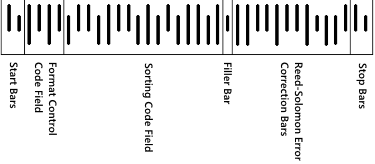
Australia Post 4-State Customer Code |

The Australia Post 4-State Customer Code is a variation of the Royal Mail 4-State Customer Code. Like the Royal Mail barcode, the Australia Post barcode is also used for faster automatic processing of bulk mail.
Australia Post 4-State Customer Code contains the following usable characters:
The ten digits, 0 - 9.
The 26 upper case letters, A - Z.
The 26 lower case letters, a - z.
The symbol, #.
The space character.
The bar density for Australia Post 4-State Customer Code is 22 to 25 bars per 25.4 millimeters. Each Format Control Code has the following minimum and maximum lengths:
|
Barcode Format Control Code |
Total Bars per Format |
Minimum Length |
Maximum Length |
|---|---|---|---|
|
Standard Customer Barcode (37) |
37 |
37.0 mm |
42.2 mm |
|
Customer Barcode 2 (52) |
52 |
52.2 mm |
59.5 mm |
|
Customer Barcode 3 (67) |
67 |
67.5 mm |
76.8 mm |
|
Reply Paid Barcode (45) |
37 |
----- |
----- |
Each complete barcode will contain distinct bars and spaces for each character as well as a start and stop bar, a checksum digit, and quiet zones on all sides of the barcode.
The bars in each barcode are separated into individual fields that contain symbols, which represent characters. The characters represent sorting rules and other information. Each character is made up of 4 separate bars. Each bar has its own numerical value and can be in one of four "states", thus the name of the symbology. The names of the four states and their corresponding values are:
T (tracker), value = 3
D (tracker, descender), value = 2
A (tracker, ascender), value = 1
H (tracker, ascender, descender), value = 0
The following is a diagram and a list of each individual field and its function:

Start Bars: The first two bars of any Australia Post 4-State Customer Code are the start bars. These bars help determine the orientation of the barcode along with the Stop Bars and always have the values 1 and 3, respectively.
Format Control Code: Identifies the format of the barcode. The FCC field uses the third through sixth (inclusive) bars.
Sorting Code Field: Identifies the Australia Post Sorting Code used for encoding the destination of the piece of mail. This field is handled by bars 7 through 22 (inclusive).
Customer Information Field: This field is only available in formats 2 and 3. The field can be 16 or 31 bars long depending on which format is used.
Reed Solomon Error Correction Bars: Used for validation of the barcode. This field is twelve bars long and is always located just before the stop bars.
Stop Bars: The last two bars of any Australia Post 4-State Customer Code. These bars help determine the orientation of the barcode along with the Start Bars and always have the values 1 and 3, respectively.
Australian Post 4-State Customer Code requires significant quiet zone space not only to the sides, but also above and below. When creating a barcode with this symbology, be sure to allow for at least 6mm of space on either side and 2mm above and below.
In order to correctly position an Australia Post Barcode, it must be printed parallel to the bottom (long) edge of the letter. The barcode must also be within the following margins.
No less than 15 mm from the bottom edge of the piece of mail.
No more than 100 mm up from the bottom edge of the piece of mail.
No less than 20 mm down from the top edge of the piece of mail.
No less than 15 mm from either side of the piece of mail.
Some other things to consider when placing your barcode are listed below.
No part of the barcode must appear in the cancelling and metering zone. The metering zone is 40 mm from the top edge and 90 mm from the right edge.
Regardless of where the barcode is placed, the address must appear in the address zone. The address zone is the same area where the barcode may be placed except the top margin is 40 mm instead of 20 mm.
The preferred position of the barcode is right above the address.